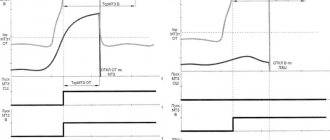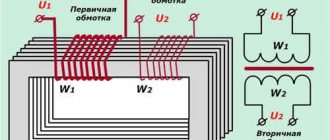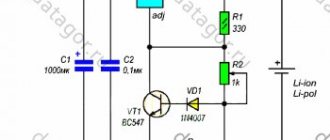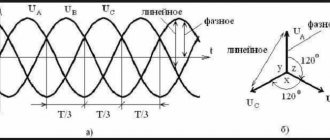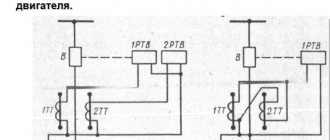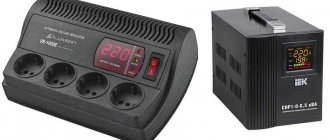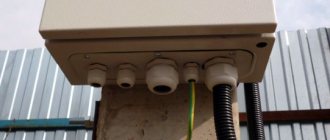Electrical energy is an integral component of the life of modern people, no matter where they live - in the city or in the countryside. It is difficult to imagine an apartment or house where there is not a single household appliance, and candles or torches are used for lighting. However, all household appliances, like lighting elements, which are powered through the home line, are at risk due to voltage instability. Exceeding the permissible limits by this indicator leads to serious problems, including breakdown of expensive equipment and line failure. 220V surge protection for the home will help protect wiring and devices. In this material we will talk about how to protect equipment with your own hands from power surges in an apartment or in a private house.
Surge Protection Relay
Protecting your home from power surges using a LV is recommended in cases where the voltage in the network is stable and its noticeable surges are rare. RN is a device capable of reading the parameters of an electric current and breaking the electrical circuit at the moment when the indicators go beyond a given range. After the indicators in the general network are normalized, the device will automatically close the circuit and restore power to consumers. The function of restoring power after a specified period of time (with a delay), built into the 220V voltage relay for the home, helps to extend the life of some household devices, refrigerators, etc.
LVs have small dimensions, relatively low cost and good performance. The disadvantages of RNs include their inability to smooth out fluctuations in electrical energy. For maximum protection of all consumers, you will need to install several devices at once.
The LV protects the network only from unacceptable voltage surges and is not intended to protect against short circuits (this function is performed by circuit breakers).
Modern launch vehicles come in three types:
1. A stationary relay built into the electrical panel of a house or apartment.
2. Relay for individual protection of one consumer.
3. Individual protection relay for several consumers.
If everything is almost clear with the operation of relays of the second and third types, then the first type LV has a more complex design, and its installation requires certain knowledge. Such devices are mounted at the entrance to the premises, thus providing protection against power surges in the network of all household electrical equipment.
Network filter
But even in the case of a reliable filter, a voltage of more than 450 V will damage it, but the equipment will remain intact, and you will have to buy a new filter. The surge protector will also be a good protection against impulses that occur during welding, but will not protect against lightning discharge during an impulse. In conclusion, I would like to warn you against skimping on your own safety. You can object by saying that your neighbor does not have any protection against overvoltage, and for many years everything has been fine, but numerous cases of equipment failure and fires due to sudden power surges should convince a competent person of the need to equip adequate protection. What to choose, a relay, stabilizer or surge protector, is up to you to decide, based on your place of residence, the frequency of power surges and the high cost of the equipment used.
The article was written for the site.
Tags:Electricity
Selecting a launch vehicle
When choosing a relay to protect your home network, it is enough to know the rating of the electric current that the input circuit breaker is capable of passing through. If, for example, the switch capacity is 25A (which corresponds to a power consumption of 5.5 kW), then the performance characteristics of the LV should be one step higher - 32A (7 kW). If the switch is designed for 32A, then the relay must withstand a current of 40 - 50A.
loauser FORUMHOUSE
For this case, I took a 40 A relay, with an input circuit breaker of 25/32 (the first one is, but the setting will increase).
Some people choose a PH brand based on total power consumption. This is not entirely correct. After all, a relay capable of withstanding a current of 32A can safely operate both at a load of 7 kW and at a much higher power consumption. Only in the second case, it is necessary to integrate a special magnetic contactor into the working circuit of the LV. But more on that in the next section.
Technogenic reasons
- In apartment buildings, especially older ones, the power lines are very worn out; the cross-section may not comply with the standards of the Electrical Installation Rules (PUE). In addition, there are cases of unauthorized repairs and independent replacement of wiring performed by uncertified home “electricians.” Contact groups (terminal blocks) are damaged by corrosion and numerous burns of contact points. Twisting of wires from various metals occurs, which leads to electrochemical corrosion.
In this condition of the wiring, even a serviceable and high-quality transformer substation is not able to provide stable parameters when the load current changes. Voltage surges in the power grid are especially noticeable in the summer (when residents turn on their air conditioners) and when it gets dark. - Transformer substations were built in the last century. As a result of wear and tear, the equipment is not able to withstand current overloads, so serious voltage sags constantly occur. Some of these transformers do not have stabilization means structurally.
- Increasing additional consumption capacity at the linear level. Any substation has a power reserve. If it is not activated, then short-term overloads are absorbed by the current reserve, and the voltage remains stable. As a result of uncontrolled development, power engineers are forced to connect new lines to existing networks, completely choosing a reserve. sometimes, due to the corruption of representatives of energy companies, the developer even manages to exceed the consumption limit. As a result, power grids are constantly operating in overload mode, and the slightest increase in power consumption inevitably leads to voltage surges.
- Increase in energy load on the scale of each apartment (household). A modern resident (especially in an urban environment) inevitably increases the number of electrical appliances used. Each room has a TV; the apartments have computers, dishwashers, and multicookers. Air conditioning has long been included in the standard equipment of a home. Of course, each personal input to the electrical network is limited by a circuit breaker. But its maximum current rating is not designed for constant consumption on the verge of operation. When the current strength in each apartment is close to the triggering threshold of the machine, the networks experience significant overloads and the voltage drops.
- Break or loss of contact on the neutral line. In this case, the voltage does not disappear (as with a single-phase connection), but increases sharply. The excess can be several hundred volts: cases have been recorded when the voltage in the emergency network reaches 400–500 volts. It is clear that under heavy loads these differences lead to the activation of linear protective equipment. And if consumption is below average, household appliances break down. Even a fire is possible.
- Unauthorized switching of electrical networks at the input. Some unscrupulous residents use it as a neutral, plumbing or heating system, to bypass electricity meters. In this case, a scatter in the phase and zero lines occurs. In addition to the danger of touching heating radiators, such art leads to power surges in the network.
- Connecting industrial equipment to household lines. Quite often you can observe how, during the construction of a household or a commercial facility (stall), a team works with a powerful concrete mixer or a welding transformer, powered from a conventional power panel. Of course, consumption in active mode of the order of 5–10 kW at one point leads to voltage drops on the line.
- It happens that a household power line is located in close proximity to high-voltage masts, or the contact wire of a trolleybus or tram route. In this case, an induced voltage effect is possible.
- We must not forget about natural factors. We are not just talking about a direct lightning discharge directly into a power line (although this does happen).
Statics is a serious problem not only when a thunderstorm front passes through power lines (even without lightning), but also during so-called dry winds.
LV installation
The standard diagram for installing a LV in a distribution panel is shown in the figure. This is the simplest protection against power surges.
Work on installing the pH should only be carried out with the main switch turned off!
As you can see, everything is simple: the control relay is installed immediately after the electric meter and is connected to the phase wire through which power is supplied to the entire house. When a surge occurs beyond the set (adjustable) range, the relay disconnects the external power supply from the internal electrical wiring, and protection against voltage surges is provided in the apartment and in the house.
The pH mounted in the panel panel takes up minimal space on the DIN rail.
If the power of home network consumers totals 7 kW or more, manufacturers strongly recommend integrating an additional electromagnetic contactor into the operating circuit of the LV. Although, a reliable contactor in the overall scheme will never become an extra detail, see the following comment:
Vitichek FORUMHOUSE user
It is better to install a contactor to any relay, although manufacturers write that the LV can withstand high currents. The contactor has larger contacts and lower resistance.
This device helps relieve the load on the LV contacts, independently disconnecting the power line from the general network of household consumers. The control relay, at the moment of unacceptable overvoltage, only issues a shutdown command. After this, the electromagnetic coil of the contactor disconnects the power contacts connecting the external and internal networks. The connection diagram in this case will be as follows:
Overvoltage protection system.
Permissible deviations of mains voltage according to GOST
The standard voltage level of a single-phase electrical network in our country is 230 V - this is the nominal value that all modern household appliances are designed for. According to the requirements of GOST 29322-2014 (IEC 60038:2009), which defines power quality standards, the discrepancy with this value should not exceed ±10%. Thus, in relation to a single-phase home network, the maximum permissible voltage range is 207-253 V.
Extreme values from this range, not to mention large deviations, have a detrimental effect on many modern electrical appliances, especially those that do not include a switching power supply. It should be understood that malfunction of household appliances caused by poor-quality power supply will not be considered a warranty case - the manufacturer, as a rule, stipulates such situations as follows: “The warranty does not apply to a product that fails due to increased/lowered input voltage.”
Protection against voltage surges 220V
In order for the LV to benefit its owner, its operating parameters (permissible voltage limits and power resumption delay time) must be correctly adjusted. If the operating circuit uses one pH, then the limits of permissible values should be set based on the characteristics of household appliances that are sensitive to changes. The most sensitive and expensive equipment is audio and video equipment. The range of permissible voltage values for it is 200 – 230V.
The permissible voltage deviation from the nominal values in domestic energy networks is 10% (198...242V). In the case of frequent activation of the LV, these indicators can be taken as a basis when adjusting the relay. However, in this case it is recommended to protect sensitive consumer electronics with the help of low-priced portable stabilizers.
DenBak FORUMHOUSE user
Nobody says that you need to turn off at plus or minus 15V. There is a range of maximum permissible deviations of 10%, which most devices should withstand. Based on this, you need to set approximately 190V-250V. Although, with our state of networks, especially in the private sector, everything is expected. So reasonable caution won't hurt.
In order to ensure the most reliable protection for all consumers, an electrical circuit with several relays should be used. A working protection scheme, including several LVs, allows consumers to be divided into groups - in accordance with their sensitivity to overvoltage:
- The first group includes audio and video equipment (permissible voltage values - 200 - 230V);
- The second includes household appliances equipped with an electric motor: refrigerators, air conditioners, washing machines, etc. (permissible values – 190 – 235V);
- The third group is simple heating devices and lighting (permissible values - 170 - 250V).
Each consumer group is connected to its own RN. In this scheme, the operating parameters of each relay are configured individually.
Protecting the network from overvoltage and surges.
The power resumption delay time must comply with the operating requirements for household appliances. For some refrigerators, for example, the recommended delay is 10 minutes.
Frequently asked questions from readers
- Why does a power surge occur when turning the refrigerator compressor on and off?
If this phenomenon has been bothering you constantly since installing the refrigerator or with the onset of winter, then the problem lies in the starting currents of the electric motor.The windings themselves are electrical coils assembled in a special sequence determined by the type of motor.
Without the flow of electric current, the entire resistance of the windings is only an active component, determined by the length and cross-section of the conductor. Due to the fact that the active component is too small, according to Ohm's law, the current flowing through the windings is several times greater than the rated one.
After the occurrence of electric current in the windings, an electromagnetic field is also created, which determines the inductive component of their resistance. Due to the inductive component, the electrical resistance increases significantly, and the current, which is inversely proportional to it, decreases.
As a result, the load on the circuit is significantly reduced, and the electric motor enters its nominal operating mode.
A noticeable voltage drop when the refrigerator is turned on is only possible if the power limit is exceeded. This is possible when the majority of consumers on the line have turned on powerful appliances (heaters, ovens, electric kettles, etc.), which already creates a power deficit and lowers the voltage.
To combat starting currents, there are soft starters that can be purchased and installed in the electric motor circuit. In addition, if the voltage at the input to your home is significantly less than 230V, you can purchase a voltage stabilizer both separately for the computer and for the entire apartment.
Surge Protectors
If your house experiences constant power surges, the LV will operate several times a day, de-energizing the entire house. Therefore, in such cases, a less simple, more expensive, but also more practical method of protecting home electronics is recommended. It consists of using stabilizers - devices that smooth out voltage surges in the external network, producing a constant 220V output.
Based on the type of connection, there are two types of stabilizers: local (which are connected to an outlet, protecting from one to several consumers) and stationary (connected to the input power cable and protecting all consumers of the home network). Local stabilizers should be used to protect the most sensitive household appliances. They can be used in conjunction with a stationary launch vehicle. Stationary stabilizers are complex devices that not only smooth out voltage drops throughout the entire household network, but are also capable of saving expensive equipment by automatically turning off the power to consumers when overloaded and reaching critical values.
It is highly recommended to install stationary stabilizers if the voltage value goes beyond 205...235V several times a day (this can be determined using an ordinary tester).
If the lights in the house are constantly blinking, and the voltage goes beyond 195...245V, then using household electrical appliances without a stabilizer is prohibited!
Where to complain and how to compensate for damage?
Complaints and compensation for damages must be made to the company with which the contract for the provision of electricity services has been concluded. Please note that rapid consideration is facilitated by the submission of collective applications, so if the incident affected neighbors on the street or other residents of an apartment building, we recommend that you organize yourself and act together. Contact details of the service provider are indicated in the contract.
If household appliances burn out during power surges, to receive compensation you must proceed in the following order:
- It is necessary to contact the energy company so that its representatives record the fact of the accident and draw up a corresponding report.
- Equipment that has become unusable must be taken to a service center to draw up an examination confirming the fact that the devices have failed and indicating the reason.
- A letter of complaint is written to the electricity supplier; a copy of the accident report and the expert opinion of the service center is attached to the letter.
- If the company refuses to compensate for losses, then the dispute is resolved in the district court.
How to choose a stabilizer
The stabilizer should be selected based on the total power of household consumers. The device must have a decent amount of power.
Mishael761 FORUMHOUSE user, Moscow.
The power reserve should be 2 times greater than existing needs. That is, a 10 kW stabilizer is designed for half the actual load (5 kW) at a minimum external voltage of 150 volts (i.e., with a large drop). This should be taken into account when choosing.
Voltage stabilizer in the panel: installation
It is recommended to install the stabilizer near the power panel in accordance with the following diagram.
The stabilizer (as well as the LV) should be integrated into the overall circuit directly after the meter. After all, these devices are also consumers, therefore, they cannot be installed in front of the meter.
How to deal with power surges
We will leave systemic measures to the power engineers. Their direct responsibility is to maintain generating and linear networks in proper condition. The task of consumers is to record voltage anomalies and immediately report them to the company to which you pay your electricity bills. If this does not help, you need to complain to the control authorities and seek the provision of quality services.
The correct operation of electrical appliances depends on us (consumers). Of course, first of all it is necessary to monitor the state of internal networks on “our” side of the meter. The circuit breakers (plugs) must be in good working order and the internal wiring must correspond to the load. If your socket network is made on a wire with a cross-section of 1.5 mm², you cannot use powerful electrical appliances on this line.
Protection of three-phase networks using a stabilizer
Let's say right away that three-phase stabilizers are designed to protect exclusively three-phase consumers. If three-phase power supplies your home, then to create a stable voltage in the internal network, it is advisable to install a separate single-phase stabilizer for each phase.
This approach will significantly reduce your costs (3 stabilizers with a power of 5, 7 and 10 kW are always cheaper than one device rated at 30 kW). In addition, if there is a voltage drop in one of the phases, the three-phase device will de-energize the entire house. This is a design feature of a stabilizer aimed at protecting three-phase electric motors.
You can discuss the features of choosing and operating stationary stabilizers by visiting the corresponding section of our forum. If you are interested in sharing your personal experience of installing a voltage control relay paired with a contactor, then we also have a suitable topic for this case. A video detailing the installation of the panel and junction box will help you connect your apartment to the power supply system in accordance with generally accepted rules for electrical installation work.
▍Act four. Protection for the most delicate.
I included this section for the sake of completeness. In addition to varistors and arresters, there are also protection devices - semiconductor suppressors (TVS-transient voltage suppressor), also known as TVS-diodes, also known as semiconductor voltage limiters. These are specially designed diodes that operate on the reverse branch of the current-voltage characteristic (yes, the same one where reversible electrical breakdown occurs in varistors). Physically, they perform the same function as other protection devices - they do not conduct current if the voltage is normal and begin to conduct current if the voltage for some reason exceeds the permissible value, thereby acting as a limiter. The photo shows a fairly large specimen, they can be quite miniature: Photo from the catalog of my favorite Promelelectronics.
TVS diodes come in both lead-out and surface-mount packages. There are assemblies with several TVS diodes to protect groups of lines. Semiconductor voltage limiters are almost perfect in all respects, except for one thing - the amount of pulse energy that they are able to limit by absorbing excess is very small. Creating protection based on them that can at least somehow compare the characteristics with arresters or varistors will be too expensive. Therefore, they have found application where compact protection of the most delicate and sensitive electronics from small power surges, for example from static electricity, is needed. Rest assured - in your phone, all contacts that lead inside (USB, headphones) are protected by small TVS diodes that will not allow the voltage on these contacts to rise above 5 V, even if you accidentally “click” them with electricity while taking off your sweater.
If you want to learn more about semiconductor voltage limiters, you can do so here and here. But, if you are not an electronics developer, then it is unlikely that you will somehow interact with these protection devices.

